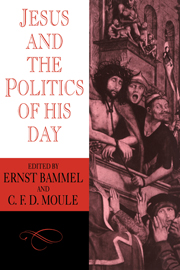Book contents
- Frontmatter
- Contents
- Abbreviations
- Foreword
- The Zealots and Jesus
- The revolution theory from Reimarus to Brandon
- The date and character of Mark
- Some observations on Tendenzkritik
- Argumentum e silentio
- The Poor and the Zealots
- The opposition between Jesus and Judaism
- Judaeo-Christianity and the Jewish establishment, A.D. 33–66
- A.D. 70 in Christian reflection
- The trial of Jesus in the Acta Pilati
- Christ as brigand in ancient anti-Christian polemic
- Jesus as a political agent in a version of the Josippon
- The Feeding of the Multitude
- The coin of ‘Render unto Caesar …’ (A note on some aspects of Mark 12: 13–17; Matt. 22: 15–22; Luke 20:20–26)
- Render to Caesar
- The Temple tax
- ‘Not peace but a sword’: Matt. 10:34ff; Luke 12: 51ff
- The decision of the Supreme Court to put Jesus to death (John 11:47–57) in its context: tradition and redaction in the Gospel of John
- The ‘triumphal’ entry
- The two swords (Luke 22: 35–38)
- The titulus
- Romans 13
- Biblical criticism criticised: with reference to the Markan report of Jesus's examination before the Sanhedrin
- The political charge against Jesus (Luke 23: 2)
- The trial before Pilate
- ‘His witness is true’: A test of the Johannine claim
- Index of Authors
- Index of References
The revolution theory from Reimarus to Brandon
Published online by Cambridge University Press: 19 January 2010
- Frontmatter
- Contents
- Abbreviations
- Foreword
- The Zealots and Jesus
- The revolution theory from Reimarus to Brandon
- The date and character of Mark
- Some observations on Tendenzkritik
- Argumentum e silentio
- The Poor and the Zealots
- The opposition between Jesus and Judaism
- Judaeo-Christianity and the Jewish establishment, A.D. 33–66
- A.D. 70 in Christian reflection
- The trial of Jesus in the Acta Pilati
- Christ as brigand in ancient anti-Christian polemic
- Jesus as a political agent in a version of the Josippon
- The Feeding of the Multitude
- The coin of ‘Render unto Caesar …’ (A note on some aspects of Mark 12: 13–17; Matt. 22: 15–22; Luke 20:20–26)
- Render to Caesar
- The Temple tax
- ‘Not peace but a sword’: Matt. 10:34ff; Luke 12: 51ff
- The decision of the Supreme Court to put Jesus to death (John 11:47–57) in its context: tradition and redaction in the Gospel of John
- The ‘triumphal’ entry
- The two swords (Luke 22: 35–38)
- The titulus
- Romans 13
- Biblical criticism criticised: with reference to the Markan report of Jesus's examination before the Sanhedrin
- The political charge against Jesus (Luke 23: 2)
- The trial before Pilate
- ‘His witness is true’: A test of the Johannine claim
- Index of Authors
- Index of References
Summary
Milton, in his Paradise Regained, portrays his vision of Satan trying to lure Jesus to plot with the Parthians to deliver the ten tribes and to establish his realm ‘from Egypt to Euphrates and beyond’ and to set up a kingdom that ‘Rome or Caesar not need fear’ and, then, improving on this by producing the yet more tempting prospect that Jesus should expel the monster Tiberius from the throne, ‘a victor-people free from servile yoke’ and aim ‘at no less than all the world’.
Just as according to the rules of the Greeks a satyr play follows the tragedy, so a burlesque of Milton's scene may perhaps be found in Schiller's Die Räuber, where Spiegelberg playfully suggests the idea of setting up as a descendant of Herod and calling forth all those who do not eat pork, pretending ‘das Königreich wieder aufs Tapet zu bringen’.
In this way the idea of political messianism, both in conjunction with Jesus and apart from him, attracted the imagination of the poets. On the plane of research, however, it was due to the work done by H. S. Reimarus that the problem came into focus. His essay on Jesus's and his disciples' goal is, as has been maintained, the first landmark of research on the life of Jesus. It is startling that the question of a political involvement of Jesus already plays a role in this first analysis. Jesus was not just a teacher of virtues; rather he was or became the herald of the ‘kingdom’.
- Type
- Chapter
- Information
- Jesus and the Politics of his Day , pp. 11 - 68Publisher: Cambridge University PressPrint publication year: 1984
- 9
- Cited by



